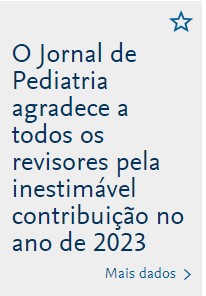to determine the prevalence of pulmonary hemorrhage in newborns and evaluate the associated risk factors and outcomes.
Methodsthis was a retrospective case-control study involving 67 newborns who met the criteria for pulmonary hemorrhage. A control was selected for each case: the next-born child of the same gender, similar weight (± 200g) and gestational age (± 1 week), with no previous pulmonary hemorrhage and no malformation diagnosis. Factors previous to pulmonary hemorrhage onset, as well as aspects associated to the condition, were assessed.
Resultsthe prevalence was 6.7 for 1,000 live births, and the rates observed were: 8% among newborns < 1,500g, and 11% among newborns < 1,000g. Intubation in the delivery room (OR=7.16), SNAPPE II (OR=2.97), surfactant use (OR=3.7), and blood components used previously to pulmonary hemorrhage onset (OR=5.91) were associated with pulmonary hemorrhage. In the multivariate logistic regression model, only intubation in delivery room and previous use of blood components maintained the association. Children with pulmonary hemorrhage had higher mortality (OR=7.24). Among the survivors, the length of stay (p ≤ 0.01) and mechanical ventilation time were longer (OR=25.6), and oxygen use at 36 weeks of corrected age was higher (OR=7.67).
Conclusionspulmonary hemorrhage is more prevalent in premature newborns, and is associated with intubation in the delivery room and previous use of blood components, leading to high mortality and worse clinical evolution.
determinar a prevalência de hemorragia pulmonar entre os recém-nascidos inter- nados no serviço e avaliar os fatores de risco e prognóstico associados.
Métodosestudo retrospectivo caso-controle com 67 recém-nascidos que preencheram os critérios pré-estabelecidos de hemorragia pulmonar. Para cada caso, foi selecionado um controle: a próxima criança nascida do mesmo sexo, com semelhantes peso (± 200g), idade gestacional (± 1 semana) e sem hemorragia pulmonar ou malformações. Foram estudados fatores prévios à ocorrência da hemorragia pulmonar e aspectos decorrentes do evento.
Resultadosa prevalência foi de 6,7 a cada 1.000 nascidos vivos, sendo de 8% entre os recém-nascidos menores que 1.500g e de 11% entre os recém-nascidos menores que 1.000 g. A necessidade de intubação (IOT) em sala de parto (OR=7,16), uso de hemoderivados previamente à ocorrência de hemorragia pulmonar (OR=5,91), uso de surfactante (OR=3,7) e SNAPPEII ≥ 30 (OR=2,97) foram associados à hemorragia pulmonar. No modelo de regressão logística multivariado, a necessidade de IOT (OR=5,12) e uso de hemoderivados (OR=4,2) mantiveram essa associação. As crianças com hemorragia pulmonar apresenta- ram maior mortalidade (OR=7,24), entre as sobreviventes, maior tempo de internação (p ≤ 0,01), mais uso de oxigênio com 36 semanas (OR=7,67) e maior duração da ventilação mecânica (OR=35,6).
Conclusãoa hemorragia pulmonar é uma doença de maior prevalência em recém-nascidos pré-termos, e está associada à intubação em sala de parto e ao uso prévio de hemoderiva- dos, acarretando maior mortalidade e pior evolução clínica das crianças.
Como citar este artigo: Ferreira CH, Carmona F, Martinez FE. Prevalence, risk factors and outcomes associated with pulmonary hemorrhage in newborns. J Pediatr (Rio J). 2014;90:316–22.









